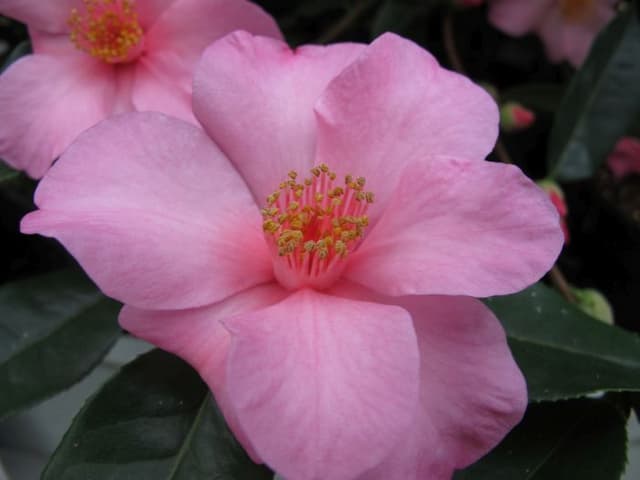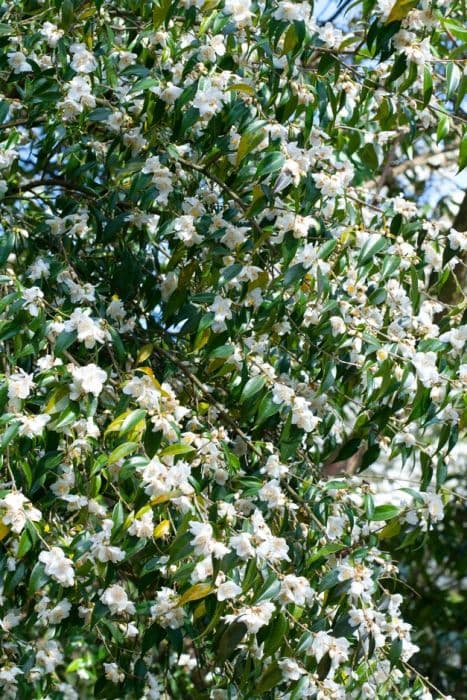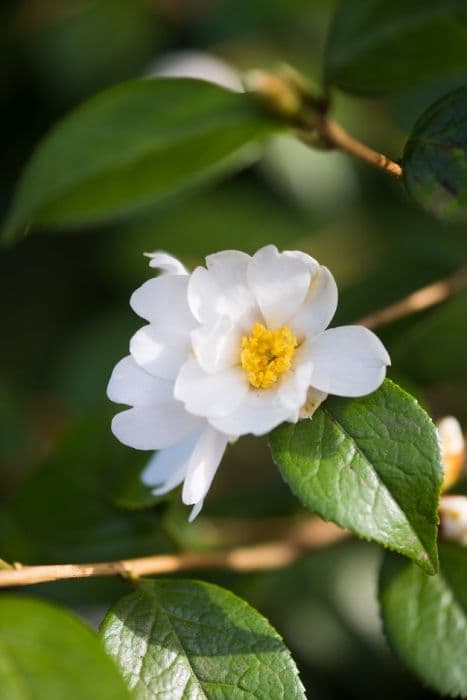Showa-no-sakae Camellia Camellia hiemalis 'Showa-no-sakae'

ABOUT
The Camellia hiemalis 'Showa-no-sakae', also commonly known as a camellia, boasts a lush and vibrant appearance, making it a favorite among ornamental shrubs for gardens and landscapes. This plant features glossy, dark green leaves that provide a perfect backdrop for its striking flowers. The blooms are notably lavish and semi-double, showcasing a soft pink hue that can range from delicate pastel to a more pronounced pink as they mature. The petals have a ruffled appearance that adds a sense of depth and texture to the flower. At the center of each bloom, a cluster of bright yellow stamens contrasts beautifully with the pink petals, attracting the attention of both onlookers and pollinators. Overall, the camellia produces a dazzling floral display that can add a touch of elegance to any setting in which it is grown.
About this plant
 Names
NamesFamily
Theaceae
Synonyms
Autumn Camellia, Winter Camellia, Showa-no-sakae Camellia
Common names
Camellia hiemalis 'Showa-no-sakae'
 Toxicity
ToxicityTo humans
The Autumn Camellia (Camellia hiemalis 'Showa-no-sakae') is generally not considered toxic to humans. It does not typically cause any serious symptoms if ingested. However, it's always prudent to avoid eating ornamental plants as they are not intended for consumption, and individual reactions can vary.
To pets
The Autumn Camellia (Camellia hiemalis 'Showa-no-sakae') is also generally not considered toxic to pets. Similar to humans, consuming parts of this plant should not result in serious symptoms of poisoning in pets. It’s always best to keep an eye on your pets and prevent them from ingesting plants not meant for consumption to avoid any potential gastrointestinal discomfort.
 Characteristics
CharacteristicsLife cycle
Perennials
Foliage type
Evergreen
Color of leaves
Green
Flower color
Pink
Height
4-5 feet (1.2-1.5 meters)
Spread
4-5 feet (1.2-1.5 meters)
Plant type
Shrub
Hardiness zones
7
Native area
Japan
Benefits
 General Benefits
General Benefits- Ornamental Appeal: Offers vibrant pink blooms that add aesthetic value to gardens and landscapes.
- Year-Round Interest: Evergreen foliage maintains color and structure throughout the seasons.
- Durable: Resistant to pests and diseases, promoting reduced maintenance requirements.
- Adaptable: Tolerant of various soil types, though it prefers well-drained, acidic soils.
- Size Control: Easily maintained and shaped through pruning to suit small gardens or containers.
- Cultural Significance: Associated with elegance and spring, it is often used in festive occasions and traditional celebrations in Japan.
 Medical Properties
Medical PropertiesThis plant is not used for medical purposes.
 Air-purifying Qualities
Air-purifying QualitiesThis plant is not specifically known for air purifying qualities.
 Other Uses
Other Uses- Culinary Garnish: The bright blooms of the sasanqua can be used to decorate salads and desserts, adding a splash of color to the presentation.
- Natural Dyes: The petals of sasanqua can be used to create natural dyes for fabrics, offering hues ranging from soft pinks to deeper tones depending on the concentration.
- Aromatherapy: The delicate fragrance of sasanqua flowers can be infused into oils and used in aromatherapy for a calming effect.
- Art Supplies: The petals and leaves can be pressed and used in art projects, such as creating botanical prints or enhancing handmade papers.
- Bonsai: Sasanqua is suitable for bonsai cultivation, providing a flowering option for enthusiasts of this traditional Japanese art form.
- Wedding Decor: Its elegant flowers can be used in wedding bouquets or as table decorations, bringing natural beauty to the celebration.
- Photography Prop: The vibrant and attractive sasanqua can serve as a stunning prop or backdrop for photographers, especially in portrait and macro photography.
- Cultural Symbols: In some cultures, sasanqua flowers can be used as symbols in ceremonies and rituals, representing purity or transitions.
- Flower Arranging: Sasanqua branches with buds and blossoms can be incorporated into floral arrangements for a touch of elegance.
- Educational Tool: The plant can be used in educational settings to teach botany and horticulture, showcasing different aspects of plant growth and care.
Interesting Facts
 Feng Shui
Feng ShuiThe Camellia is not used in Feng Shui practice.
 Zodiac Sign Compitability
Zodiac Sign CompitabilityThe Camellia is not used in astrology practice.
 Plant Symbolism
Plant Symbolism- Longevity: Camellias often symbolize longevity due to their ability to live for a very long time and bloom year after year.
- Perfection: The Camellia's perfectly structured petals represent the ideal of perfection and excellence.
- Admiration: Giving a Camellia can indicate deep admiration for someone's qualities.
- Devotion: The enduring nature of the Camellia blossom signifies deep and steadfast devotion in relationships.
- Love: In some cultures, Camellias represent love and affection, especially when given as a gift.
 Water
WaterAutumn Camellia, commonly known as Showa-no-sakae, needs to be watered thoroughly when the top 2 to 3 inches of soil feel dry to the touch. Ensure the water penetrates deeply into the soil to encourage root growth. Typically, this may equate to watering about 1 to 1.5 gallons per week, depending on weather conditions and soil drainage. During active growth in spring and summer, watering frequency should increase, especially in dry spells, but always allow the soil to partly dry before watering again. In winter, reduce watering but do not allow the soil to become completely dry.
 Light
LightAutumn Camellia prefers bright, filtered light with protection from the harsh afternoon sun. The best spot for this plant is in partial shade, such as under a canopy of tall trees that provide dappled sunlight. A north-facing or east-facing location where it can receive gentle morning light and avoid the strong midday sun is ideal.
 Temperature
TemperatureAutumn Camellia thrives in conditions where the temperature ranges between 40 and 80 degrees Fahrenheit. They can survive minimum temperatures down to about 10 degrees Fahrenheit but require protection from cold winds and frost. The ideal temperature for robust growth and flowering would be a consistent range between 50 and 70 degrees Fahrenheit.
 Pruning
PruningAutumn Camellia should be pruned to maintain shape, remove dead or weak branches, and promote airflow within the canopy. Pruning is best done after the blooming period has finished, in late winter or early spring. Light pruning can be done as needed throughout the year to remove dead flowers and any diseased or damaged wood.
 Cleaning
CleaningAs needed
 Soil
SoilThe Autumn Camellia prefers well-drained, acidic soil with a pH between 5.5 and 6.5. A mix of 1/3 pine bark, 1/3 garden soil, and 1/3 peat moss is often recommended for optimal growth and flowering.
 Repotting
RepottingAutumn Camellias are typically repotted every 3 to 5 years, but it's best to do so when the plant becomes root-bound or the soil appears exhausted.
 Humidity & Misting
Humidity & MistingAutumn Camellias thrive at humidity levels of 40-50%, but can tolerate a range. It's important not to let the air get too dry, especially in indoor environments.
 Suitable locations
Suitable locationsIndoor
Place in bright, indirect light with proper soil mix and water.
Outdoor
Plant in partial-shade, sheltered spot with acidic soil.
Hardiness zone
7-9 USDA
 Life cycle
Life cycleCamellia hiemalis 'Showa-no-sakae', commonly known as the Winter Camellia, begins its life cycle as a seed, which after germination continues to grow into a seedling with the first set of true leaves. As the plant matures, it develops a sturdy root system and lush foliage, eventually reaching a shrubby form. During the vegetative stage, it invests energy in growth and prepares for flowering, with buds forming typically at the end of the growing season. The Winter Camellia enters the blooming phase in late autumn to winter, flaunting semi-double to double pink flowers that attract pollinators, vital for sexual reproduction. After pollination and fertilization, seeds develop and are dispersed, sometimes with the help of animals or environmental conditions. The plant may live for many years, undergoing periods of growth and flowering, and can also be propagated vegetatively using cuttings, creating genetically identical clones of the parent plant.
 Propogation
PropogationPropogation time
Spring-Early Summer
Propogation: The Camellia hiemalis 'Showa-no-sakae', more commonly known as the Sasqua camellia, is commonly propagated through semi-hardwood cuttings. The most suitable time for taking cuttings is in late summer to early fall. A cutting typically measures about 4 to 6 inches long with several leaves. The lower leaves are removed, and the cut end is often dipped in a rooting hormone to enhance root development. The prepared cutting is then inserted into a mix of moist peat and perlite or a well-draining potting mix. Keeping the cuttings under a humidity dome or in a propagator and ensuring they have gentle warmth and indirect light can improve rooting success. It generally takes several weeks for the cuttings to root adequately before they can be transferred to individual pots.









